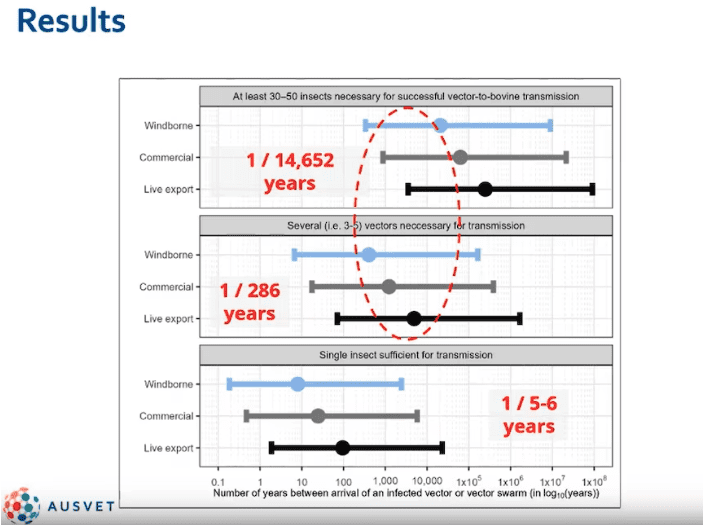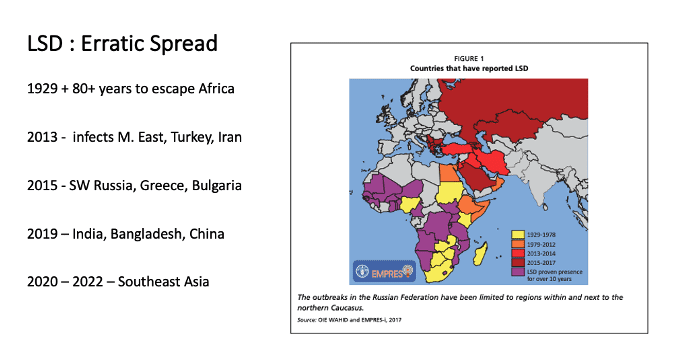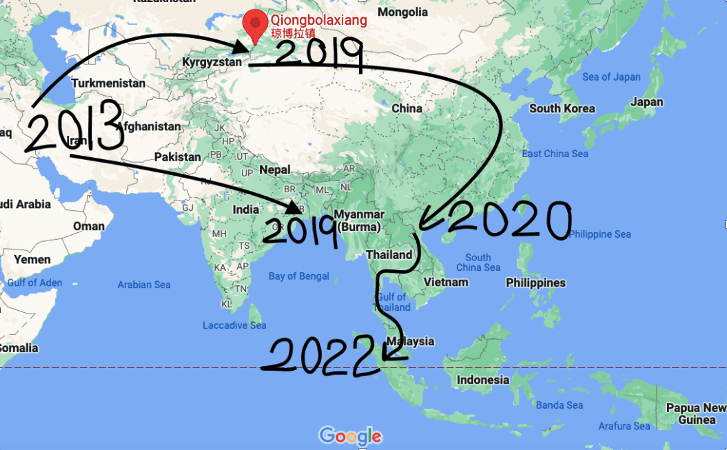I do not write this article to criticise the Ausvet team or their excellent research, but I am concerned that the optimistic view presented of the future risk of LSD incursion to Australia could potentially lead to government and industry assuming that the risks are very small and potentially drop their guard.
Earlier this month. the National Farmers Federation hosted a webinar updating industry on the Foot and Mouth and Lumpy Skin disease (LSD) situation in Indonesia including a presentation by Dr Cowled, a researcher and director of Ausvet, on their latest LSD research.
The modelling (reported by Beef Central back in March) showed that the risk of an LSD outbreak in Australia ranged from between one in every five years, to one in every 14,652 years, depending on the number of insects required for successful transmission.
“It shows it’s not a very high likelihood of an outbreak if it takes quite a few insects to start an outbreak”, Dr Cowled said. Dr Cowled explained that the research team expected the “truth” would be “an outbreak every few hundred years or every few thousand years”. However, he noted the confidence intervals of the modelling were not high, with many questions left to be answered by science.
In an earlier structured expert judgement (SEJ) exercise, specialists estimated there was a 28% chance of an LSD outbreak (via any pathway) occurring in Australia in the next five years (Centre of Excellence for Biosecurity Risk Analysis, 2022). SEJ exercises are not based on modelling but use an internationally recognised process to make evaluative judgements on a range of complex and uncertain systems.
One of the key themes of the webinar was that we should be alert but not alarmed. I have read the research paper, all 127 pages, and it appears to me to be a sound scientific analysis of the available data given the methodology that the researchers were asked to follow which was essentially a risk assessment to answer the question: “Assuming a situation where LSDV is endemic throughout Southeast Asia and Papua New Guinea, how many LSDV incursions into Australia per year are estimated through the four specified non-regulated pathways? These pathways were: windborne dispersal of arthropod vectors, commercial vessels carrying hitchhiker arthropod vectors, returning live export vessels carrying hitchhiker arthropod vectors and Torres Strait Treaty movements carrying hitchhiker arthropod vectors.
I have no arguments or criticism with the paper or its conclusions.
The problem for me is that the findings have been presented to industry as the current, scientific view of future risk of LSD entering Australia.
But the researchers were only asked to assess the risks of entry via the four pathways specified above. The researchers clearly stated that confidence intervals of the modelling were not high, with many questions left to be answered by science. “There’s quite a bit of uncertainty in our estimates”.
In my opinion, recent, actual, real world transmission evidence (confirmed by FAO and OIE) is also relevant and rather alarming when it comes to estimating how long it will take for LSD virus to reach Australia.
What we do know as fact based on recent disease transmission is that the means of spread of LSD is very poorly understood, erratic, inconsistent and exceptionally difficult to predict or explain using the current scientific understanding of the disease.
My crudely modified map below is in my view the most powerful evidence available that suggests the arrival of LSD in Australia is inevitable and potentially not too far away.
If it is so difficult to transmit LSD virus by insects then how did it get from the deserts of the Middle East across the “Stan” countries over snow-capped mountains to north west China where the winter temperatures get down to -40C? How did LSD get from the frozen northwest of China all the way east to Beijing and then down through eastern China to Hanoi in a single year? How did the disease manage to travel from Vietnam through Laos and Cambodia to Thailand, down the Malay peninsula and jump the ocean gap to Indonesia during the peak of the Covid 19 lockdowns period? Never in the history of the region have the borders in Southeast Asia been so tightly closed to all levels of traffic from early 2020 to mid 2022, including live cattle road transports which traditionally move in the opposite direction from west to east?
How did the virus travel from the Middle East through Pakistan and to northeast India in six years or less. There are certainly no movements of any livestock traffic in either direction across the border between Pakistan and India. This route includes large deserts as well as temperate environments. In another strange feature of this disease, after entry to India in 2019 there were only a modest number of cases with minimal mortalities until 2022 when a highly lethal epidemic commenced in the north-western states of Gujarat and Rajasthan in June/July of 2022 which then spread to many other regions of the country. One official government report indicated that over 2 million animals were affected including 100,000 mortalities.
The disease managed to cross the Taiwan and Malacca Straits to infect Taiwan and Indonesia respectively but has so far failed to cross relatively short ocean gaps to infect Japan, the Philippines and the island of Borneo.
The simple facts are that this disease has managed to spread across a range of environments from snow-capped mountains and frozen plateaus to vast deserts, temperate zones and equatorial jungles to infect about one third of the world in about 9 years. The only thing we know for sure it that there is a great deal we are yet to discover about how this disease is transmitted. The statement “that the research team expected the “truth” would be “an outbreak every few hundred years or every few thousand years” no doubt matches the results of Ausvet’s specific research project but is potentially misleading if the broader real-world experience of the actual disease transmission during its spread across the Middle East, China, India and Southeast Asia during the last 10 years is taken into account.
I repeat, this is not a criticism of the Ausvet team or their work but an attempt to point out that the Ausvet study was restricted to assessing known possible pathways and was not tasked with an open-ended assessment including the many inexplicable disease movement events observed over recent decades. I hope that raising these points will reduce the chances that industry and government may assume that the risks are now very small and drop their guard.



